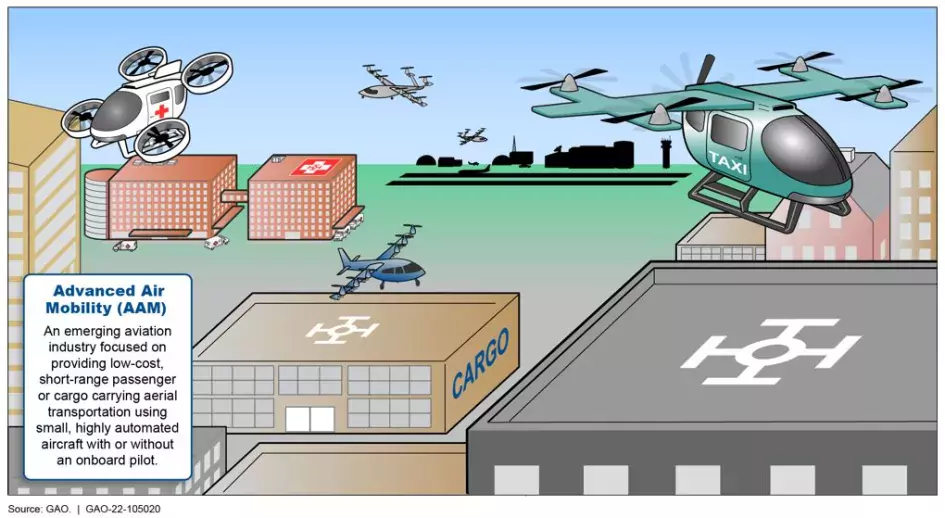How Long Until A New Advanced Aviation Industry Takes Flight?
Small, electrically-powered aircraft could soon transform the aviation market. Many of these highly-automated aircraft can take off and land vertically, and eventually they may not need a pilot to fly them.
Additionally, these aircraft may be cheaper and quieter to operate than traditional airplanes or helicopters. And they could enable new services, collectively known as Advanced Air Mobility, that would connect urban and rural areas, speed cargo delivery, and provide lifesaving medical transportation if the industry and government can address certain challenges.
In today’s WatchBlog post, we look at our new report about Advanced Air Mobility, including some of the challenges that need to be addressed before the industry can take off.
Image

What technology makes advanced air mobility possible?
For our new report, we interviewed aircraft manufacturers, trade groups, colleges and universities, and other industry stakeholders. They identified some key innovations that would allow for these services, including:
- Electrified propulsion. Using electric motors powered by batteries results in aircraft that can use many quieter engines distributed around the aircraft.
- Vertical flight. The electric motors can be operated in different ways to allow the aircraft to take off and land vertically. This allows for operations closer to the locations to be served.
- High levels of automation. Simpler, highly automated flight controls would make the aircraft easier to fly and could reduce pilot training costs and time.
What still needs to happen before Advanced Air Mobility can work?
Stakeholders also told us about several key issues that the industry and government must address before the industry can begin large-scale services, including:
- Aircraft certification. The new features of these aircraft do not fit neatly into the Federal Aviation Administration's (FAA’s) existing regulations. FAA plans to develop certification standards that use FAA’s existing regulations for the portions of the aircraft designs that fit them. For other areas that may not fit, such as vertical flight capabilities and electric propulsion, FAA must develop new but equally safe criteria.
- Infrastructure development. Advanced Air Mobility services will require new ground infrastructure that has not yet been developed. This includes facilities and equipment for aircraft to take off and land, load passengers, and charge batteries. We have ongoing work on the financing of ground infrastructure for these aircraft.
- Public acceptance. The Advanced Air Mobility industry will need to show that these aircraft are safe, reliable, and quiet in order to operate in closer proximity to people and buildings. In addition, the industry will need to demonstrate that operations complement existing local transportation options, and that the costs and benefits of new services are distributed equitably across all communities.
- Workforce development. The workforce needed to develop and conduct Advanced Air Mobility operations will require new skills and standards related to electric propulsion and highly automated operations. In addition, this industry may also face similar workforce supply constraints that have impacted the broader aerospace sector. For example, commercial airline companies and aircraft maintenance providers have struggled in recent years to recruit and retain workers due to high educational costs, lack of workplace diversity, and inadequate awareness of opportunities.
So, given the challenges, how soon could we see Advanced Air Mobility services?
The stakeholders told us that small scale Advanced Air Mobility operations could begin within five years. However, they also said that the pace at which the industry expands over the next 10 years will depend on how the industry and government are able to identify profitable markets and address the key issues described above.
Find out more about Advance Air Mobility services and their future by checking out our new report.
- Comments on GAO’s WatchBlog? Contact blog@gao.gov.
GAO Contacts
Related Products

GAO's mission is to provide Congress with fact-based, nonpartisan information that can help improve federal government performance and ensure accountability for the benefit of the American people. GAO launched its WatchBlog in January, 2014, as part of its continuing effort to reach its audiences—Congress and the American people—where they are currently looking for information.
The blog format allows GAO to provide a little more context about its work than it can offer on its other social media platforms. Posts will tie GAO work to current events and the news; show how GAO’s work is affecting agencies or legislation; highlight reports, testimonies, and issue areas where GAO does work; and provide information about GAO itself, among other things.
Please send any feedback on GAO's WatchBlog to blog@gao.gov.




